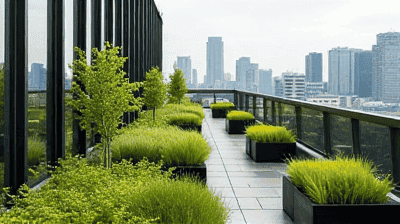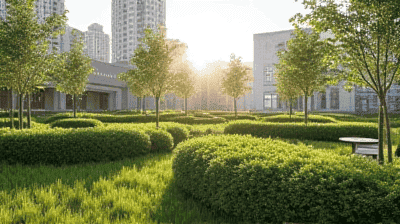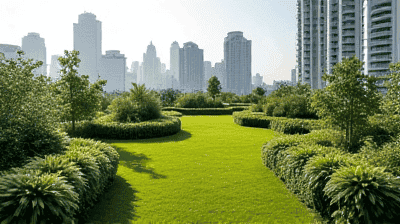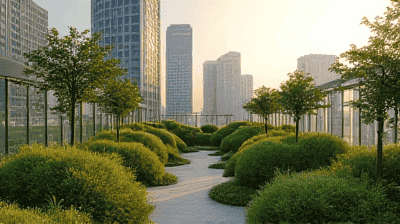
As urban areas continue to expand, the phenomenon known as the urban heat island effect has become increasingly pronounced. Cities often experience higher temperatures than surrounding rural areas due to human activities, dense infrastructure, and limited vegetation. This temperature disparity is a significant factor contributing to heat pollution, which can have deleterious effects on public health, energy consumption, and the environment. In response to these challenges, innovative solutions such as rooftop gardens and cool roofs have emerged as effective strategies to combat heat pollution.
The urban heat island (UHI) effect refers to the phenomenon where urban and metropolitan areas are significantly warmer than their rural counterparts, primarily due to human activities. The main factors contributing to the UHI effect include:
Impervious Surfaces: Materials like asphalt and concrete absorb and retain heat during the day and release it slowly at night, leading to elevated temperatures.
Lack of Vegetation: The removal of trees and green spaces for urban development reduces the cooling effect provided by shade and evapotranspiration.
Waste Heat Generation: Energy consumption from buildings, transportation, and industrial processes emits heat, which contributes to the overall increase in temperatures.
Heat pollution can have widespread impacts, including:
Public Health Risks: Elevated temperatures can lead to heat-related illnesses, exacerbating conditions such as asthma and cardiovascular problems.
Increased Energy Consumption: Hotter urban environments drive up the demand for air conditioning, leading to higher energy bills and increased strain on power grids.
Environmental Consequences: Higher temperatures can disrupt local ecosystems, reduce biodiversity, and lead to altered precipitation patterns.
Economic Effects: Cities facing extreme heat may experience decreased worker productivity and increased operational costs for cooling systems.

Rooftop gardens are green spaces created on the roofs of buildings, incorporating a variety of planting systems that can include vegetation, soil, and water. These gardens can serve multiple purposes, including aesthetics, food production, and environmental benefits.
Rooftop gardens combat heat pollution through several mechanisms:
Evapotranspiration: Plants absorb water through their roots and release moisture into the air through transpiration. This process cools the surrounding air, reducing ambient temperatures.
Increased Albedo: Unlike dark roofing materials that absorb heat, green roofs reflect more sunlight, contributing to a decrease in surface temperatures.
Enhanced Insulation: Rooftop gardens can provide an additional layer of insulation, reducing the energy requirements for heating and cooling buildings.
Biodiversity and Habitat Creation: Rooftop gardens can support a wide range of plant and animal species, promoting biodiversity and enhancing urban ecosystems.
The implementation of rooftop gardens offers numerous advantages:
Air Quality Improvement: Vegetation can filter pollutants from the air, leading to improved air quality and health outcomes for urban residents.
Stormwater Management: Rooftop gardens absorb rainwater, reducing stormwater runoff and lowering the risk of flooding in urban areas.
Social Benefits: Green spaces can enhance community well-being, encouraging recreational activities, social interactions, and environmental stewardship.
Increased Property Values: Properties with rooftop gardens may see increased property values due to enhanced aesthetics and the environmentally friendly reputation of green initiatives.
While rooftop gardens offer significant benefits, several challenges must be addressed:
Structural Limitations: The weight of soil and vegetation requires careful structural assessments to ensure that roofs can safely support green installations.
Maintenance Requirements: Rooftop gardens require regular maintenance, including watering, weeding, and pruning, which can impose additional costs and labor.
Initial Installation Costs: The upfront costs associated with creating rooftop gardens can be a barrier for some property owners, although long-term savings often outweigh initial investments.
Cool roofs refer to roofing materials designed to reflect more sunlight and absorb less heat than standard roofs. These roofs are typically constructed using materials that have high solar reflectance (albedo) and thermal emittance.
Cool roofs reduce heat pollution by:
Reflectivity: By reflecting sunlight, cool roofs can lower roof surface temperatures, which not only reduces heat absorption but also lowers the heat transferred to the building and surrounding areas.
Heat Reduction in the Urban Environment: The decreased absorption of heat by buildings can help lower overall ambient air temperatures in urban areas.
Energy Efficiency: Cool roofs can significantly reduce cooling costs by minimizing the energy required for air conditioning, leading to lower greenhouse gas emissions from energy production.
There are several types of cool roofs:
Reflective Coatings: These coatings can be applied to existing roofs, improving reflectivity without the need for complete roof replacement.
Cool Roofing Materials: New materials, such as specialized reflective shingles or tiles, can be installed to provide high thermal performance.
Green Roofs: While technically categorized as a form of a rooftop garden, green roofs also fulfill the cool roof function by reflecting sunlight and providing cooling benefits.
The implementation of cool roofs yields several advantages:
Energy Savings: Studies have shown that cool roofs can reduce cooling costs by up to 30 percent, providing significant cost savings for building owners.
Mitigation of Urban Heat Islands: Widespread installation of cool roofs in urban environments can have a measurable cumulative effect on lowering city-wide temperatures.
Extended Roof Lifespan: By reducing temperature fluctuations, cool roofs can decrease roof degeneration and extend the lifespan of roofing systems.
Improved Comfort Levels: With lower surface temperatures, occupants of buildings are likely to experience more comfortable indoor environments.
While cool roofs present numerous benefits, there are challenges involved:
Upfront Costs: The initial costs of installing cool roofing materials or applying reflective coatings can deter property owners.
Color Limitations: Some cool roofing materials may not align with aesthetic preferences or neighborhood regulations regarding color and appearance.
Maintenance: Like any roofing system, cool roofs require maintenance to ensure their reflective properties remain effective over time.

Rooftop gardens and cool roofs are not mutually exclusive; in fact, they can complement one another to provide comprehensive solutions for heat pollution:
Combined Benefits: Rooftop gardens inherently serve as cool roofs due to their reflective properties and ability to cool surrounding air through evapotranspiration. Together, they maximize temperature reductions.
Integrated Design: Urban planners and architects can design buildings that incorporate both green roofs and cool roofing materials to create multifunctional spaces that combat heat pollution and enhance environmental sustainability.
Community Engagement: Both strategies can promote community involvement and awareness regarding urban heat pollution, encouraging participation in environmental initiatives.
Several cities around the world have adopted rooftop gardens and cool roofs as part of their strategies to combat heat pollution. Highlighting successful implementations can provide insight into their effectiveness and inspire further action.
New York City has implemented its Green Roofs program, promoting the installation of green roofs throughout the city. This initiative aims to reduce urban heat, manage stormwater, and enhance biodiversity. Case studies from buildings participating in the program show significant temperature reductions on rooftops with vegetation. The exploration of cool roof technologies has complemented these efforts, leading to a more comprehensive approach.
Toronto has embraced the dual strategies of cool roofs and green roofing as part of its climate action plan. The city's Cool Roofs Initiative encourages building owners to install reflective coatings on rooftops to reduce heat absorption. Simultaneously, the Toronto Green Roof By-law promotes the installation of green roofs on new developments, reinforcing the city's commitment to sustainability and heat pollution mitigation.
Singapore is well-known for its extensive integration of greenery in urban design, including rooftop gardens. The city-state's Urban Redevelopment Authority encourages the creation of green roofs to promote sustainable construction. Not only have these initiatives contributed to reduced surface temperatures, but they have also enhanced the livability of urban spaces. The introduction of cool roofing materials in new buildings further exemplifies their commitment to combating heat pollution.
Los Angeles has embarked on a variety of initiatives to combat the UHI effect, including the installation of cool roofs. The city's Cool Roofs Program incentivizes property owners to apply reflective coatings or install cool roofing materials. In tandem, the city promotes green roofs to enhance urban greenery and reduce heat absorption. Initial studies indicate significant temperature reductions on roofs treated with cool roof technologies.

To maximize the benefits of rooftop gardens and cool roofs, supportive policy frameworks and urban planning strategies are essential:
Governments can support rooftop gardens and cool roof initiatives through financial incentives, including tax credits, grants, or subsidies, encouraging property owners to invest in these solutions.
Adopting building codes that require or incentivize the installation of green roofs or cool roofing materials can promote widespread implementation in new developments.
Engaging communities through education and outreach can raise awareness about the benefits of rooftop gardens and cool roofs, fostering a culture of sustainability and environmental mindfulness.
Collaboration between government agencies, design professionals, community organizations, and businesses is crucial in developing a cohesive strategy that integrates rooftop gardens and cool roofs within urban planning.
As cities anticipate the challenges posed by climate change and urbanization, the future of rooftop gardens and cool roofs looks promising:
Ongoing innovation in roofing materials, such as reflective membranes and advanced substrate systems for green roofs, will enhance performance while reducing costs and maintenance needs.
Further research into the impacts of rooftop gardens and cool roofs on urban heat pollution will provide valuable insights and guide policy decisions regarding their implementation.
Grassroots movements focusing on urban gardening and sustainability can elevate the discourse around heat pollution and promote localized solutions that build community resilience.
As awareness of heat pollution spreads, cities worldwide may increasingly adopt rooftop gardens and cool roofs as integral components of their urban planning and climate adaptation initiatives.
Rooftop gardens and cool roofs represent vital strategies in the fight against heat pollution exacerbated by urban development. Their ability to cool urban environments, improve air quality, manage stormwater, and enhance community well-being makes them essential in creating sustainable cities.
By embracing these innovative solutions, urban planners, policymakers, and communities can work together to combat the adverse impacts of the urban heat island effect. The integration of green spaces and reflective materials into city infrastructure has the potential to shape a more livable, resilient, and environmentally friendly urban landscape for current and future generations.